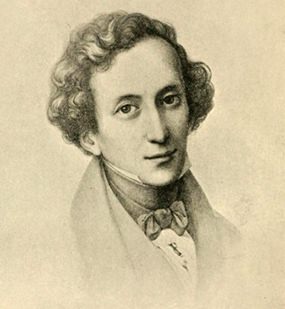Thy Sea-Encircled Isle

Mendelssohn
at 26 (Pencil Drawing by Mücke).
This evocative phrase was
created by the eighteenth century English composer Benjamin Cooke, who was
organist at Westminster Abbey and master of the Abbey’s choristers for over
thirty years. He was also organist at St. Martin-in-the-Fields so he must have
had a busy life, but he wrote little religious music and instead devoted himself
to light songs. One of these is Albion, thy sea-encircled isle.
Albion as you may recall,
is the ancient name for what is now Great Britain. The words of the song paint
a Utopian but somewhat unrealistic picture of what he described as a “happy
land,” where “kind Nature sheds her genial showers to raise thy fruits and paint
thy flowers.”
Great Britain is known
more poetically as the British Isles. This is hardly surprising because it has
about 6,289 islands. Not all that long ago, I used to live on one of the
smaller ones.
Perhaps this geographical
curiosity was why the BBC radio programme Desert Island Discs became so
popular. It’s been broadcast weekly since 1942 and the signature tune is a
piece called By the Sleepy Lagoon, by Eric Coates. Seagull cries were
dubbed over the music to add a dash of local colour but it was eventually
realised that seagulls live in the northern hemisphere and would be about as
likely on a desert island as a penguin. The sound effect was dutifully changed
to the squawking of tropical birds but this proved unpopular and the seagulls
were reinstated, no doubt to their immense satisfaction.
Britain has long been
celebrated in music by composers like Purcell, Britten, Vaughan Williams, Bax,
Elgar and Butterworth. But these of course are British composers, so it’s
hardly surprising. However, at the age of twenty, the German composer
Mendelssohn visited Britain. It had a lasting impression on him.
Felix
Mendelssohn (1809-1847): Hebrides Overture.
London
Symphony Orchestra cond. John Eliot Gardiner (Duration 10:07; Video 480p)
This concert overture is
also known as Fingal’s Cave, named after a natural feature of the
Scottish island of Staffa, one of the smallest islands of the Southern
Hebrides. Even in the nineteenth century, the cave was a tourist attraction
because of its spectacular size and appearance. The eerie sounds produced by
the echoes of waves gave it the atmosphere of a Neolithic cathedral. Its Gaelic
name means “the melodious cave”. Jules Verne came to see it and so did William
Wordsworth, John Keats, Alfred Lord Tennyson and J. M. Turner, who painted it in
1832. Even Queen Victoria made the trip.
One is tempted to ask, who
was Fingal? He was possibly (or possibly wasn’t) a mythical hunter-warrior of
Irish mythology who might (or might not) have lived in the third century.
Whoever he was, the cave would have certainly been on Mendelssohn’s itinerary
when, in the summer of 1829 he set out on a walking tour of Scotland with his
friend Karl Klingemann. After visiting the Hebrides, Mendelssohn sketched the
opening theme of the overture which came to him while watching the waves. It
was originally called Overture for a Lonely Isle, which seems to me
rather more evocative than its eventual title.
Nearly six hundred miles
to the south are the Channel Islands, which although part of Britain are closer
to France. In 1904, the composer Debussy spent some time on the island of
Jersey where he completed a piano piece he’d already started. It was called
L’isle joyeuse – The Happy Isle.
Claude
Debussy (1862-1918) L’isle joyeuse.
Marc-André Hamelin (pno) (Duration: 05:32; Video: 1080 HD)
This remarkable piece was
originally inspired by a painting by Jean-Antoine Watteau in which a merry group
of people appear to be departing for the mythical island of Cythera in the
Mediterranean, birthplace of Venus, the Goddess of Love. Debussy uses the
English spelling of “Isle” in the title rather than the French, almost certainly
alluding to Jersey where he escaped for a romantic holiday with Emma Bardac, who
eventually became his second wife.
It would seem that both
islands – the mythical one and the real one - influenced Debussy’s piece. It’s
full of lightness and grace, words that could equally apply to Watteau’s
painting. The Catalan pianist Ricardo Viñes, who gave the first performance,
said that it reminded him of Turner’s paintings. Strangely enough, Debussy was
fascinated by the paintings of J. M. Turner and he’d studied them on his first
visit to London in 1902.
Many of the features of
Debussy’s mature musical style are there, but Debussy himself admitted that the
piece “is difficult to play”. Difficult indeed, because it’s a challenge just
to play the notes in the right order at the right speed, let alone make musical
sense of them. Canadian Marc-Andre Hamelin provides a dazzling performance, and
this superb CBC video captures the excitement and magic.

